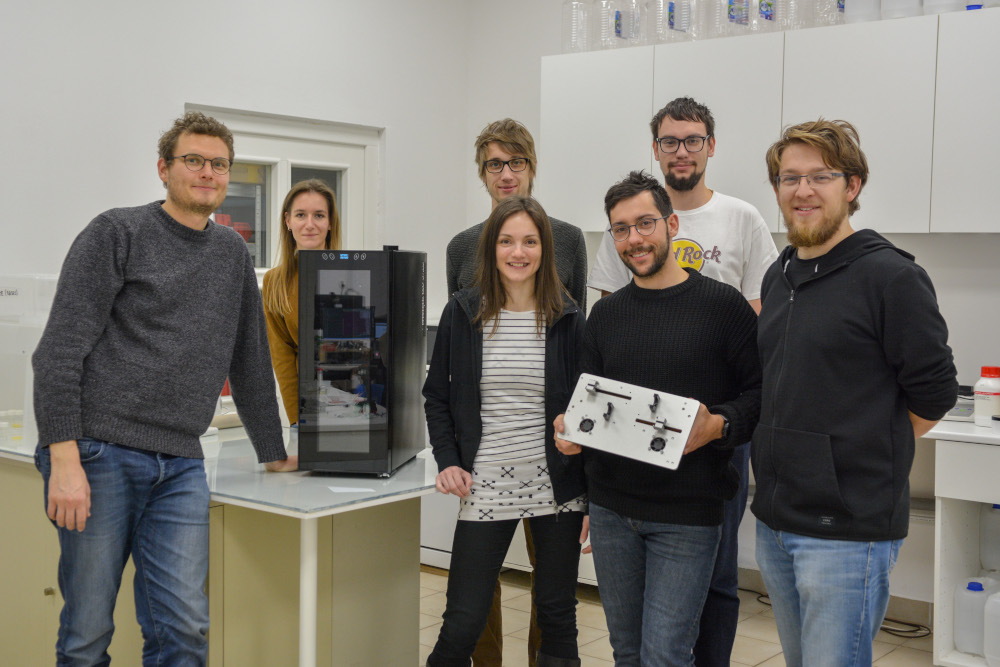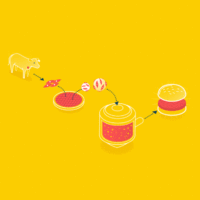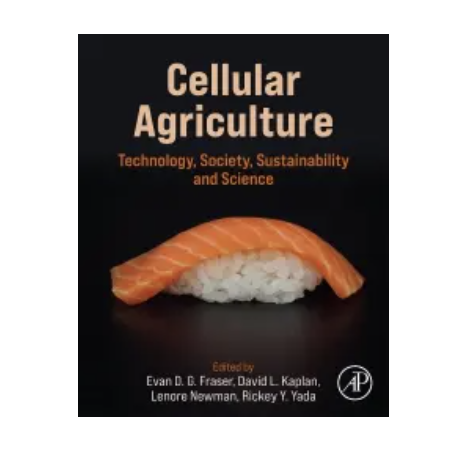- Overview
- Background
- Updates
Overview
We are building a low cost, open source modular bioreactor for in vitro tissue culture to increase global access to cellular agriculture research tools. The project is a collaboration between New Harvest, the Institute for Development of Advanced Applied Systems (IRNAS), and the Institute of Biomedical Sciences at the University of Maribor in Slovenia.
This initiative builds on a prototype created by seed grantees in the United States and Canada.
Now in Slovenia, the bioreactor travels back and forth between IRNAS and the University of Maribor as a tissue engineer tests each step and the hardware team makes changes in response.
The bioreactor is designed to rapidly adapt to a constant flurry of new research about cultured meat. Technical specifications (specs) are available on GitHub.
Updates
September, 2023 – Documentation for the system (everything you need to manufacture and build) is published openly on Github!
August, 2020 – The project team publishes a peer-reviewed paper in Food Engineering Reviews about the potential of new tools to accelerate cultured meat production.
July, 2020 – IRNAS hosts a webinar about the bioreactor.
June, 2020 – IRNAS publishes a blog post about the bioreactor.
April, 2020 – The bioreactor begins its next phase of testing!
May, 2018 – New Harvest teams up with the Institute for Development of Advanced Applied Systems (IRNAS) to turn the prototype into an operational, open source bioreactor.
January, 2018 – New Harvest’s inaugural seed grantees build the prototype and hand over the project to New Harvest for next steps.
October, 2017 – A team of undergraduate engineers reach out to New Harvest seeking funding to create a bioreactor prototype for a capstone project. Lacking a funding mechanism to support short-term research, New Harvest creates a new kind of grant—the New Harvest Seed Grant—to fund the project.
Collaborators
This initiative is a collaboration between New Harvest, the Institute for Development of Advanced Applied Systems (IRNAS), and the Institute of Biomedical Sciences at the University of Maribor.
The team includes Boštjan Vihar, Luka Banovic, and Jernej Vaja.
It builds on a prototype developed by New Harvest seed grantees Han Zhang, Kyle Manke, and Yi-Fan Chen at the University of British Columbia and New Harvest research fellow Jess Krieger at Kent State University.

The IRNAS team!
See More Initiatives

Artificial Intelligence and Machine Learning in Cellular Agriculture
Cost and scale are major blockers to cellular agriculture's success, but they are complex technical and economic challenges. Artificial intelligence (AI) and machine learning (ML) techniques could help to accelerate much of this work, but there is very little public literature on the various applications and benefits. Given the potential exponential impact of AI/ML, New Harvest and Alberta Machine Intelligence Institute (Amii) launched the AI in Cell Ag Initiative.

Safety Initiative Phase III: Precompetitive Collaboration on Safety Research and Methods Development
The Cultured Meat Safety Initiative (CMSI) is a joint initiative between New Harvest and Vireo Advisors aiming to address critical technical, methodological, and informational challenges related to evaluating the safety of cultured meat (CM) products.
CMSI involves the convening of diverse stakeholders, including industry, governmental scientists, regulators, academic researchers, and others. Gaining such varied perspectives advances public knowledge and the practice of food safety for CM products by identifying and addressing data gaps. Research conducted to develop data and methods build the necessary support elements for the emerging ecosystem, which can raise regulatory and consumer confidence, support industry efforts toward commercialization, and improve the efficacy of evaluation processes of regulatory safety reviews.
Building on progress from Phase I and Phase II of CMSI, New Harvest and Vireo Advisors are now working to convene diverse stakeholders to create the infrastructure for shared knowledge, methods, and data that address the priorities identified in Phase I and II. Our long-term goal is to coordinate and launch regional efforts to develop and validate analytical methods for CM safety analysis and use these methods to generate datasets that can be made publicly available to support transparent food risk assessments and policy-making processes.

The Foundational Cellular Agriculture Textbook
Cellular Agriculture: Technology, Society, Sustainability and Science was designed to be the go-to reference for everyone in cellular agriculture - the textbook found in every company’s office, in every university lab, and in every aspiring student’s backpack.
The text provides a state-of-the-art review of cellular agriculture technologies, presenting foundational information with practical application insights. There are chapters on regulatory and policy issues, as well as reviews of the sustainability challenges of alternative proteins.
It is the first resource of its kind to take a practical approach to review the design, feasibility, and implementation of cellular agriculture techniques. With additional chapters on life cycle analyses and ideal transition scenarios, this book provides a resource for aspiring technology developers and academics alike seeking evidence-based assessments of the industry and its disruptive potential. The textbook was written by industry and academic experts for a balanced perspective of the field today and to inspire and shed light on a path forward.

